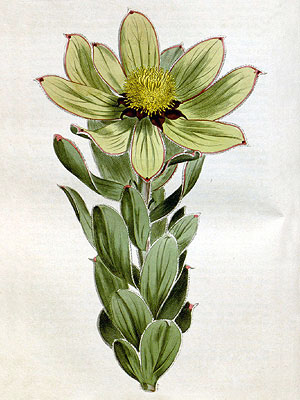Wolseley Conebush (Leucadendron spirale)
The Wolseley Conebush was described in 1809; it was restricted to a small area in the Lower Breede River Valley in the Western Cape Province, South Africa.
The species was last seen in 1933 and is now considered extinct.
*********************
edited: 17.02.2024
Tag Archives: Proteaceae
Persoonia prostrata R. Br.
The Prostrate Persoonia is, or maybe was, endemic to the northern tip of Fraser Island in Queensland, Australia, where it was found growing in sand dunes as well as in woods.
The species was described in 1810, it is known from only two collections and may in fact just be a prostrate form of another species, the Broad-leaved Persoonia (Persoonia stradbrokensis Domin) (see photo), which, however, is not known to grow on Fraser Island. [1]
The Prostrate Persoonia was a prostrate shrub with elliptic to spathulate, up to 5 cm long leaves.
The species is probably extinct.
*********************
References:
[1] Peter H. Weston; L. A. S. Johnson: Taxonomic changes in Persoonia (Proteaceae) in New South Wales. Telopea 4(2): 269-306. 1991
*********************

Broad-leaved Persoonia (Persoonia stradbrokensis)
Photo: C. T. Johansson
(under creative commons license (3.0))
https://creativecommons.org/licenses/by-sa/3.0/
*********************
edited: 09.11.2021
Persoonia laxa L. A. S. Johnson & P. H. Weston
This taxon was described in 1991, it is known exclusively from herbarium material that was collected in 1908 at what today is a suburban area of Sydney, the capital of New South Wales, Australia.
The species is most likely extinct. [1]
*********************
References:
[1] Peter H. Weston; L. A. S. Johnson: Taxonomic changes in Persoonia (Proteaceae) in New South Wales. Telopea 4(2): 269-306. 1991
*********************
edited: 09.11.2021
Leucadendron grandiflorum (Salisb.) R. Br.
Wynberg Conebush (Leucadendron grandiflorum)
The Wynberg Conebush obviously was described on the basis of a drawing, made from a plant grown in Great Britain, to where it was imported as a garden plant around 1809.
The only information about the species we have today is that it originated from a place called Wynberg, which today is a southern suburb of the city of Cape Town in Western Cape, South Africa.
The Wynberg Conebush disappeared around about 1800, when its habitat was destroyed due to urbanization. [1]
*********************
References:
[1] N. A. Helme; T. H. Trinder-Smith: The endemic flora of the Cape Peninsula, South Africa. South African Journal of Botany, Vol. 72(2): 205-210. 2006
*********************

(public domain)
*********************
edited: 03.11.2020
